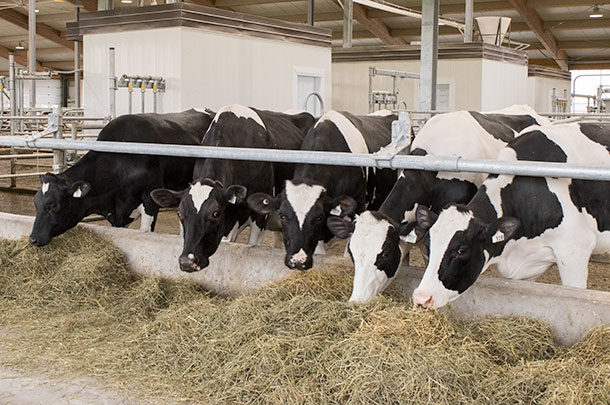There has been substantial research over the last few years on pre-fresh (dry cow) diets. Controlling energy consumption through the incorporation of low-energy ingredients such as straw and poor-quality hay has been shown to improve transition cow health.
Overfeeding energy during the dry period has resulted in reduced performance and higher incidences of metabolic disorders:
- Lower fresh cow DMI and slower starts in milk production
- Higher NEFA (non-esterified fatty acids) in blood and more triglyceride in the liver after calving
- Greater deposition of fat in the dry cow with moderate overfeeding of non-lactating cows for 57 days leads to increase in visceral adipose tissues (omental, mesenteric and perirenal) than in cows fed a high-straw diet to control energy intake at requirements
- Decreased neutrophil function postpartum (Controlled energy intake during the dry period improved neutrophil function, which may lead to better immune function.)
Many producers have adopted the controlled-energy diet with a one-group dry cow feeding scenario. The success of this program is largely related to controlling bodyweight gain and condition through the far-off period.
The question of implementing a close-up (higher-energy) diet is often discussed with the intention of improving the transition from the dry cow diet to the milking cow diet. But does this close-up strategy really work?
Researchers at Ohio State University completed an experiment designed to determine whether moving dry cows to a higher-energy close-up diet at three weeks before calving would be beneficial to cows during the transition compared with a single high-bulk diet fed all the way through to calving.
The cows in the one-group dry cow diet had the least change in dry matter intake (DMI) after calving and lower concentration of fat in the liver as compared to the cows fed a far-off and close-up diet.
The researchers concluded there was little evidence the two-group strategy offered any advantage compared with the single-diet (controlled-energy high-fibre) strategy.
The potential “stumbling block” for the one-group feeding strategy is the marked difference in the pre-fresh and post-fresh diets.
The pre-fresh diet is bulky and low-energy while the post-fresh is usually a denser, higher-energy diet with shorter material. Improving the transition between these two diets and optimizing DMI in the fresh period is critical for success.
The severity of negative energy balance (NEB) for the fresh cow is related to energy output and energy intake. The primary driver for energy intake is not energy density of the diet but the DMI.
Improving DMI in the fresh period will reduce the severity of fresh cow NEB. Research has shown that the fresh cow DMI can be improved by employing strategies such as:
- Feeding sugar and reducing starch
- Reducing forage fibre with non-forage fibre sources
- Reducing forage fibre with non-forage fibre sources and reducing starch levels
Ensuring a smooth transition from the pre-fresh to the post-fresh diet will improve DMI. What other strategies can be used to improve this transition? The dry cow ration and the fresh cow ration are remarkably different on paper but should “look” similar to the cow. This can be accomplished by:
1. Reducing particle size of the dry cow TMR to “mimic” the particle size of the lactating TMR.
- Using finely chopped straw (less than 1 inch) will create a non-sortable ration for the dry cow. Use the Penn State Forage Separator (with three compartments) to evaluate. Aim at:
- Less than 10 percent top
- Less than 45 percent middle
- Less than 45 percent bottom
- The reduced particle size will increase passage rate through the rumen and lead to higher DMI in the pre-fresh group. Because of the higher DMI, more chopped straw should be added to control energy intake.
- The higher DMI pre-calving will be closer to the expected DMI post-calving; decreasing this gap will improve the transition between the two diets. Feeding a higher-energy/denser diet (such as a close-up diet) can also lead to higher DMI pre-calving, but this will result in higher concentration of liver fat.
2. Feed similar ingredients pre- and post-calving. Many nutritionists and producers worry about incorporating haylage into the dry cow diet due to potassium (K) concerns. However, keeping the diet ingredients between the two groups similar will improve the transition.
- Keeping total diet K levels low (less than 1.2 percent of DMI) is a key strategy when incorporating haylage into the diet. Incorporate low-K ingredients in the diet (see Figure 1) to complement the inclusion of haylage.
- Using corn silage and chopped straw without haylage poses some issues with the diet. If we aim at achieving a 14 percent crude protein diet, then additional purchased protein sources such as soymeal may need to be added, but these can also add significant energy and potassium. As shown in Figure 1, haylage is often a better nutritional choice.
 3. Increase density (kg per cubic foot) of the pre-fresh diet or lower the density of the fresh cow diet. Because of the bulky nature of the chopped straw diet, there may be a noticeable difference in the density (kg per cubic foot) of the pre-fresh and the post-fresh diet.
3. Increase density (kg per cubic foot) of the pre-fresh diet or lower the density of the fresh cow diet. Because of the bulky nature of the chopped straw diet, there may be a noticeable difference in the density (kg per cubic foot) of the pre-fresh and the post-fresh diet.
This can be measured by constructing a cubic foot box and weighing both TMRs – pre- and post-calving. The goal for a “seamless” transition would be to keep these densities closer together.
- Add water to the pre-fresh TMR. A wetter TMR will both increase the density and reduce sorting behaviour.
- Add chopped hay to the fresh cow TMR to lower the density of the fresh cow TMR.
4. Ensure fermentability of the diet. The dairy cow’s microbial population requires nitrogen and carbohydrates to fuel growth. Having a healthy and vibrant population at calving will improve the transition to the fresh cow diet.
- Add fermentable carbohydrate sources such as beet pulp or soyhulls in the dry cow diet. These are moderate energy sources as compared to corn but will add fermentability.
- Add urea as a fermentable nitrogen source. This also helps control energy while trying to maintain appropriate protein levels in the diet.
5. Using ketogenic ingredients (beet pulp, sugar, whey permeate) in the fresh cow diet may improve the energy available for rumen papillae and encourage rumen microbial growth.
Ketogenic ingredients are ingredients that tend to shift ruminal VFA to increased levels of butyrate. Butyrate is the primary VFA that supplies energy to the rumen and may be involved in rumen papillae growth.
Butyrate is converted to BHBA by the ruminal papillae for fuel. Ruminally derived ketones do not pose a problem, while hepatic-derived ketones are indicative of a problem (incomplete oxidation of fatty acids or ketosis).
Let’s use a practical example with the help of Nathan Siebenga of Jubilee Farms in Atwood, Ontario. Siebenga mechanically reduces the particle size of the wheat straw for his dry cow diet.
Using the Penn State Forage Separator on both the dry cow ration and milk cow ration, we determined that both diets were close in particle size (Table 1 and Figure 2).

 Figure 3 shows how the density (kg per cubic foot) was determined using a box (1 foot high by 1 foot square) that is filled (without packing) with the dry cow TMR and the lactating cow TMR.
Figure 3 shows how the density (kg per cubic foot) was determined using a box (1 foot high by 1 foot square) that is filled (without packing) with the dry cow TMR and the lactating cow TMR.
 The dry cow TMR was 10 kg AF per cubic foot (5.158 kg DM per cubic foot), and the lactating TMR was 14 kg AF per cubic foot (6.45 kg DM per cubic foot). The goal would be to reduce this gap by increasing the density of the dry cow ration with the addition of water or “bulk out” the fresh cow TMR with some chopped dry hay.
The dry cow TMR was 10 kg AF per cubic foot (5.158 kg DM per cubic foot), and the lactating TMR was 14 kg AF per cubic foot (6.45 kg DM per cubic foot). The goal would be to reduce this gap by increasing the density of the dry cow ration with the addition of water or “bulk out” the fresh cow TMR with some chopped dry hay.
Working towards a seamless transition program by altering the texture and density of the dry cow TMR may be an effective strategy for the transition cow program.
Designing a dry cow diet that mimics the physical properties of the lactating diet but is nutritionally designed for the dry cow will improve this delicate transition balance. PD
References omitted due to space but are available upon request. Click here to email an editor.

-
Bill Woodley
- Ruminant Technical Services Manager
- Shur-Gain
- Email Bill Woodley











